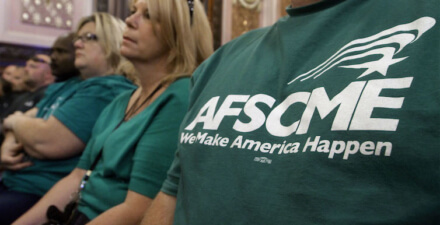The 2022 Midwest Economic Association annual meeting features key sessions on labor market monopsony

The Midwest Economic Association held its 86th annual meeting this past weekend, featuring six important sessions on labor market monopsony that the Washington Center for Equitable Growth co-organized as part of its ongoing commitment to support new research on inequality and growth, as well as increase diversity in the economics profession by supporting scholars in various phases of their careers and from an array of backgrounds and institutions.
The six sessions on various topics on monopsony featured a wide range of participating scholars, among them Equitable Growth grantees, early career academics, and non-U.S. researchers. The sessions were part of more than 100 total sessions held in person in Minneapolis on March 25–27 to discuss and present research in all areas and specializations of economics.
Leading up the monopsony sessions were Kate Bahn, the director of labor market policy and chief economist at Equitable Growth, and Todd Sorensen, an associate professor of economics at the University of Nevada, Reno. The sessions tackled labor market monopsony as it relates to market concentration in the United States, laws and institutions, policy and power, structural models and theoretical advancements, the role of the minimum wage, and international perspectives. We sum up the highlights below.
U.S. labor market monopsony concentration
This session discussed research examining concentration through different lenses to understand how concentrated power in the U.S. labor market affects employment outcomes. Presenting were:
- Hyeri Choi, a Ph.D. candidate at the University of Pennsylvania’s School of Social Policy and Practice. She discussed underemployment—measured by involuntary part-time work—affected by local market concentration as measured by the Herfindahl-Hirschman Index, a common measure of concentration, drawing from her working paper, “The Impact of Labor Market Concentration on Unemployment and Underemployment,” co-authored by her UPenn colleague and Equitable Growth grantee Ioana Marinescu.
- Justin Wiltshire, a Ph.D. candidate at the University of California, Davis and an Equitable Growth grantee. He discussed the impact on local labor markets when a new very large employer enters a local market, drawing from his working paper, “Walmart Supercenters and Monopsony Power: How a Large, Low-Wage Employer Impacts Local Labor Markets.”
- Aaron Sojourner, an associate professor at the University of Minnesota’s Carlson School of Management. He examined his new work measuring the prevalence and impact of common ownership by investment firms that partially own public companies that are employers in local labor markets, drawing from his latest working research on common ownership impacting wage outcomes, with Jose Azar at the University of Navarra and Yue Qiu at Temple University.
Monopsony and U.S. laws and institutions
This session examined the role of employee contracts in determining employment relationships, including three papers on noncompete agreements in the United States and an analysis of collective bargaining in South Africa. The presenters in this session demonstrated how the provisions that structure employment relationships determine outcomes, rather than pure market forces. Presenting were:
- Peter Norlander, an associate professor of management at Loyola University Chicago’s Quinlan School of Business. He discussed his painstaking efforts to collect data on noncompete agreements among employers who are public-sector contractors through the federal Freedom of Information Act, using software to pull the text of the contracts and creating a database on noncompete agreement clauses, for his latest working paper, “Non-Solicitation Clauses in Public Sector Outsourcing Contracts.”
- Michael Lipsitz, at the U.S. Federal Trade Commission’s Bureau of Economics and Mark Tremblay, an assistant professor of economics at Miami University. They presented their working paper, “Noncompete Agreements and the Welfare of Consumers,” finding that ultimately, noncompete agreements risk harms to workers and consumers.
- Ihsaan Bassier, an Equitable Growth doctoral grantee and Ph.D. candidate in economics at theUniversity of Massachusetts Amherst. He presented his research on “Collective Bargaining and Spillovers in Local Labor Markets,” which examines how South Africa’s bargaining council agreements impact wage structures in local labor markets when there is strategic interaction between firms.
- Alison Pei, a Ph.D. student at Duke University. She presented her research on “The Enforceability of Noncompete Agreements and Innovation: Evidence from State Law Changes,” co-authored with Equitable Growth grantee Matthew Johnson at Duke University, Michael Lipsitz at the FTC, and Kurt Lavetti at The Ohio State University. Their work finds that greater enforceability of noncompete agreements reduces patenting levels within a state but increases the quality of patents as measured by how often those patents are cited in future patenting.
Monopsony and policy and power
This session examined the scope and success of changing the policy environment that shapes labor market competition in the United States and China. Presenting were:
- Michael Neugart at the Technical University of Darmstadt. Neugart discussed his work with Marcel Steffen Eckardt, also of the Technical University of Darmstadt, on the scope needed for policy in both antitrust and labor policy to be effective in raising wages, given lack of competition, drawing from their working paper, “Policy Complementarities to Curb Market Power and Raise Real Wages.”
- Brianna Alderman, an undergraduate McNair Scholar at the University of Florida’s School of Economics, and Roger Blair, professor and chair of economics at the University of Florida. They presented their latest working paper, “Monopsony, Wage Discrimination, and Public Policy.”
- Ida Brzezinska from the University of Oxford in the United Kingdom. She presented her work, co-authored with Jin Jo Kim of Oxford Policy Management, on how removing policies that are labor market barriers—specifically the Hukou system in China—improves outcomes for workers, drawn from their working paper, “The Working Dread? Analysing the Impact of the Hukou Reform on Firms’ Monopsony Power in China.”
Monopsony: Structural models and theoretical advancements
This session featured cutting-edge theoretical work guiding new empirical research on monopsony. Each paper presented an extension of theoretical models of monopsony, then used these models to conduct novel empirical analysis. Presenters were:
- Glen Kwende, a Ph.D. candidate in economics at American University and an Equitable Growth grantee. He presented his job market paper, “Endogenous Wage Rigidity in a Search and Matching Model,” which builds a monopsony model of the labor market that is able to explain the pay-productivity gap in the United States.
- Jelena Nikolic, an associate professor of humanities and social sciences at the Wentworth Institute of Technology. Niklolic presented a research paper, co-authored with Richard Disney, emeritus professor of economics at the University of Sussex, titled “Monopsony with Heterogeneous Labour: Evidence from Economic Transition,” which examines how the transition from Soviet central planning in Eastern Europe to a market-based system in the 1990s impacted labor market competition for workers.
- Mons Chan, an assistant professor of economics at Queen’s University. He presented his work, co-authored with Kory Kroft at University of Toronto and Elena Mattana and Ismael Mourifié at Aarhus University, drawn from their working paper, “An Empirical Framework for Matching with Imperfect Competition.”
- Bryan Seegmiller, a Ph.D. candidate in financial economics at the Massachusetts Institute of Technology Sloan School of Management and an Equitable Growth grantee. He presented his latest working paper, “Valuing Labor Market Power: The Role of Productivity Advantages.” This model finds that more productive firms exercise greater wage-setting power in monopsonistic labor markets.
Monopsony: The role of minimum wage
The papers presented in this session looked at how the structure of the labor market shapes outcomes when minimum wages are instituted. Three papers looked at how concentration and labor market frictions determine outcomes for Germany’s sectoral minimum wage policies. The fourth paper looks at the mix of wage offers and job quality, given labor market frictions impact outcomes when a corporate minimum wage policy is present. Presenters were:
- Iain Bamford, a Ph.D. candidate in economics at Columbia University. He discussed his job market paper, “Monopsony Power, Spatial Equilibrium, and Minimum Wages.” In this model, Bamford finds that a flat minimum wage improves welfare outcomes, compared to a targeted regional minimum wage, and does not reduce employment in locations that experience a greater proportional increase to wages, referred to as the “bite” of the minimum wage increase by economists.
- Martin Popp, a postdoctoral scholar and junior researcher at the Institute for Employment Research, or IAB, in Germany. He presented his latest research, “Minimum Wages in Concentrated Labor Markets,” which finds minimum wages have a relatively greater impact in markets with high levels of concentration as measured by the Herfindahl-Hirschman Index.
- Gökay Demir, a Ph.D. candidate and researcher at the Leibniz Institute for Economic Research, or RWI, in Germany. He presented his research, “Labor Market Frictions and Spillover Effects from Publicly Announced Sectoral Minimum Wages.” This work finds that nearby firms anticipate a minimum wage increase in Germany’s sectoral minimum wage structure by increasing their own wage offer in response.
- Suresh Naidu, a professor of economics and international and public affairs at Columbia University and an Equitable Growth grantee. He presented his latest Equitable Growth funded work, co-authored with Arindrajit Dube at the University of Massachusetts Amherst and Adam Reich at Columbia University, on Walmart Inc.’s $11 hourly corporate minimum wage and the relative presence of local labor market frictions in each labor market in which the stores operate and how that changes the mix of wages and job quality for those workers, drawing from their latest research, “Power and Dignity in Low-Wage Labor Markets: Evidence From Wal-Mart Workers.”
Monopsony: International perspectives
This session covered monopsony across the context of different countries, which demonstrated how the structure of labor markets in different countries and their labor market institutions impact outcomes resulting from labor market frictions. Papers presented in this session were:
- “Labor Market Power, Self-Employment, and Development,” by Pamela Medina at the University of Toronto, Francesco Amodio at McGill University, and Monica Morlacco at the University of Southern California, Los Angeles. This paper examines how the high prevalence of an informal self-employed sector in Peru interplays with the labor market power of concentrated firms, with workers flowing between the two sectors.
- “Monopsony Power in the Labor Market and Employer Branding,” by Céline Detilleux and Nick Deschacht at KU Leuven in Brussels, Belgium. In a vignette experiment, where the researchers field survey questions on hypothetical labor market trade-offs, they find that employers have a greater ability to undercut wages when they brand themselves as having an attractive workplace culture and values.
- “Monopsony Rents and Local Club Goods,” by Peter Brummund at the University of Alabama and Michael Makowsky at Clemson University.
- “How Has Labour Market Power Evolved? Comparing Labour Market Monopsony in Peru, Viet Nam and the United States,” by Ekkehard Ernst of the International Labour Organisation and Jorge Davalos at the Universidad del Pacífico. This comparative analysis examines how monopsony has changed over time across different international contexts.
Equitable Growth grantees and network members elsewhere at the Midwest Economic Association annual meeting
Several Equitable Growth grantees and other network members participated or were featured in various other sessions over the course of the annual conference. A few highlights included:
- “Doing Inclusion in Economics,” a panel organized by Abigail Wozniak, an Equitable Growth grantee and director of the Opportunity and Inclusive Growth Institute of the Federal Reserve Bank of Minneapolis. She and her panelists discussed the link between people and practice in economics, research in response to pressing inclusion questions, engaging students from a broad range of backgrounds, and improving inclusion in the editorial process. The session featured Monica Garcia-Perez, a professor of economics at St. Cloud State University, a former ASHE president and a guest speaker at Equitable Growth’s Vision 2020 conference. This presentation also included highlights from a recent Minneapolis Fed event on racism in economics.
- “The Changing Labor Market and the Future of Work,” a panel chaired by the AFL-CIO Chair professor of labor policy at the Humphrey School of Public Affairs and the University of Minnesota and Equitable Growth grantee Morris Kleiner. This panel featured several papers co-authored or presented by Equitable Growth grantees, including:
- “Medicaid-ing Uninsurance? Reducing the Duration of Uninsurance Spells,” by co-author and Equitable Growth grantee Elena Patelat at the University of Utah
- “Unemployment Insurance Incentives and Platform Gig Work” and “New Work or Changes in Reporting? A Framework for Measuring Self-Employment Trends in Administrative Data,” both co-authored by Equitable Growth grantee Andrew Garin at the University of Illinois at Urbana-Champaign
- “Changing Income Risk Across the U.S. Skill Distribution: Evidence from a Generalized Kalman Filter,” co-authored by Equitable Growth grantee Kyle Herkenhoff at the University of Minnesota
- “Income Inequality and Mobility,” a panel chaired by Equitable Growth grantee Stephen Woodbury at Michigan State University and the Upjohn Institute.
Monopsony power and guest worker programs
February 28, 2019
Concluding note
Equitable Growth was able to elevate new, cutting-edge research on monopsony in the labor market at this year’s Midwesterns, but the conference also provided us with an important way to engage with and highlight the work of many of our network members and staff and to introduce our research to this audience for the first time. We look forward to exploring additional engagement and collaboration opportunities with the Midwest Economic Association and other regional economics and social sciences conferences in the future.






